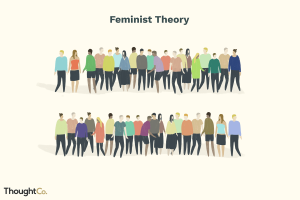In the course of the 1970s, the need emerged to deconstruct the female role, traditionally categorised in a sexual-maternal sense, at a time when “deconstructing” meant distancing the female social role from the classical representation of women as the “angel of the home and the family”. In this sense, unhinging the “biological maternal destiny” becomes the prevailing goal of the theoretical and applicative orientations of 1970s feminism, according to which, sex and motherhood constitute two aspects closely linked to patriarchy and sexism as constitutive of female oppression.
The 1960s and 1970s were characterised by the spread of themes centred on the re-appropriation of female sexuality, a sexuality experienced in an intimate and personal way by women, no longer subject to patriarchal control, and in particular, in the 1970s, feminism also highlighted the theme of motherhood no longer understood as a social duty, but rather as a personal value and individual choice (Sapegno 2011: 155). The most interesting aspect to emphasise – with reference to feminism in the 1970s – is that relating to the themes of free sexuality and motherhood as an intrinsic aspect of women’s self-determination over their own bodies, themes that were relevant and topical until the 1980s and 1990s. In fact, in the 1970s, major reforms that characterised the social and public role of women were being discussed: from the introduction of divorce, to the establishment of family advice centres, to debates on abortion and its regulation (Marella 2008: 344).
Especially in radical feminism, the theoretical-political conceptualisation, takes on the conformation of a substantive critique of the historical connection between heterosexual normativism and patriarchal culture. Analytically, the theoretical approaches of feminism – in particular, radical feminism – converge in the reflection that posits the social system as a factor characterised by the power struggle between the sexes. In the 1970s, a fundamental characteristic of feminism is to consider fundamental to the critique of patriarchy, the idea that society as a whole is an unjust system, in which women constitute subordinate categories subject to various types of discrimination (Vukoičić 2013: 35).
Through the influences of Marxist theory and the incredibly significant importance of its themes relating to class struggle, conflict, exploitation and revolution, feminist theoretical reflection began to base its application instances on Marxist orientations, in order to outline a programme for the liberation of women their pre-established role of subordination in the private sphere, starting with a strong critique of private property, identified as the main expression of patriarchal and heterosexual domination over women. On this basis, a feminist literature has developed on the subject of the “productive” exploitation of the female body.
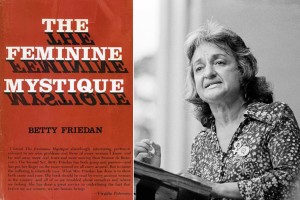 From this perspective, the radical orientation of feminism necessarily converges with Marxist theorising, shifting the analytical axis of women’s repression and gender inequality to an essentially sexual-maternal level. In 1963, the great writer and feminist Betty Friedan, in her most successful work The Feminine Mistique (Friedan 1963) linked the theme of women’s liberation to a critique of motherhood as a social obligation, in a line with another great interpreter of feminism, Adrienne Rich, who in Of Woman Born. Motherhood As Experience and Institution (Rich 1976), intended to emphasise not so much motherhood in its social identification – motherhood as an instrumental aspect of patriarchal aims – but motherhood as the incontrovertible experience of women.
From this perspective, the radical orientation of feminism necessarily converges with Marxist theorising, shifting the analytical axis of women’s repression and gender inequality to an essentially sexual-maternal level. In 1963, the great writer and feminist Betty Friedan, in her most successful work The Feminine Mistique (Friedan 1963) linked the theme of women’s liberation to a critique of motherhood as a social obligation, in a line with another great interpreter of feminism, Adrienne Rich, who in Of Woman Born. Motherhood As Experience and Institution (Rich 1976), intended to emphasise not so much motherhood in its social identification – motherhood as an instrumental aspect of patriarchal aims – but motherhood as the incontrovertible experience of women.
These positions also refer to the various obstacles women have had in the course of their lives, with the marriage and motherhood.
The contribution made by these two authors is truly enlightening, since it pays attention to the social conception of marriage identified as a “cage” or “prison”. In this sense, Adrienne Rich’s reflection highlights the significance of maternity interpreted socially as a normative translation of the principle of heterosexuality. According to Rich, heterosexuality and motherhood are political institutions, which is why it is crucial to conceptualise the meaning of female motherhood differently, as motherhood perceived in terms of a social-institutional obligation is opposed to a woman’s self-determination over her own body.
As we could observe from Adrienne Rich’s reflection, it is interesting to note that, precisely, motherhood was one of the most relevant issues for the feminist movement, because this question, fundamental from the first “wave” of feminism, became a unifying element for the same women who, historically, united to claim their rights. In fact, the issue of motherhood has been one of the fixed points on which patriarchy – from the very beginnings of human history – has extended its restrictive forces, with the aim of categorising the role of women on a sexual and maternal view of the female body, at the same time denying them their rights and discriminating against them politically and professionally. In these terms, it is understandable to understand why the “redefinition” of the concept of autonomy has become the focal point of feminist reflection.
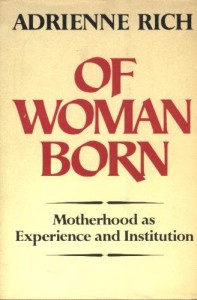 This awareness, especially since the 1970s and 1980s, has oriented feminism towards the elaboration of a new perspective on gender “difference”, a difference that does not mean a lack of something or inferiority, but simply refers to a diversity of approach and reflection that must exist between women and men, particularly on topics pertaining to sexuality, the body and motherhood.
This awareness, especially since the 1970s and 1980s, has oriented feminism towards the elaboration of a new perspective on gender “difference”, a difference that does not mean a lack of something or inferiority, but simply refers to a diversity of approach and reflection that must exist between women and men, particularly on topics pertaining to sexuality, the body and motherhood.
In this regard, Luisa Muraro, writer, philosopher and exponent of the “Diotima” community, in one of most important works of feminist literature, L’ordine simbolico della madre (Muraro 1991) speaks of the importance of recovering the mother figure by using a “politics of the symbolic”. According to Muraro, rediscovering the maternal relationship is the main way to renew even the “metaphysical” philosophical experience as an authentic experience “of being” (Muraro 1991: 41).
After all, if the history of Western metaphysics has been characterised by an obscurantist androcentrism, i.e. that linguistic and cultural system referred to as the “symbolic order of the father”, the need to deconstruct such a restrictive and constrictive system must necessarily emerge, instead, constructing a new “symbolic maternal order”, capable of renewing a new thought and language purified of patriarchal practices and centred on the “power” of maternal relationships.
Luisa Muraro’s position exemplifies the opposition directed by feminist thought against the so-called “Oedipus complex”, which has constituted an essential point in the question of male-female sexual difference. It should be noted that the entire history of psychoanalysis has been determined as a patriarchal expression that, in particular, in Sigmund Freud’s psychoanalytic theory, links male virility with an equivalent female sexual inferiority.
«Considering the overriding objective of its struggles, the demolition of the patriarchal power system, second-wave feminism holds that the radical deconstruction patriarchal power system, second-wave feminism holds that the radical deconstruction of the of language is an obligatory path […] the theoretical reflection focuses on the subsisting connection between language and sexual/existential domain, so stringent as to reduce, in fact, the space of thought and action for women» (Cavaliere 2019: 371).
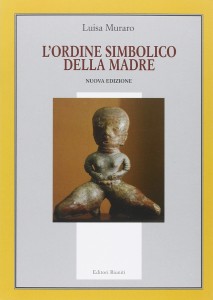 Feminist reflection on the theme of sexuality, certainly, had the merit of giving great importance to the “sexual difference” of women as a true and only alternative capable of overcoming the traditional and limiting identification on the level philosophical, anthropological and psychoanalytic of the “masculine-phallic”. From this point of view, the philosopher Luce Irigaray’s reflection is emblematic, according to which in the archetypal “phallic” representation one can read the original structure of relations between man and woman (Irigaray 1978: 48).
Feminist reflection on the theme of sexuality, certainly, had the merit of giving great importance to the “sexual difference” of women as a true and only alternative capable of overcoming the traditional and limiting identification on the level philosophical, anthropological and psychoanalytic of the “masculine-phallic”. From this point of view, the philosopher Luce Irigaray’s reflection is emblematic, according to which in the archetypal “phallic” representation one can read the original structure of relations between man and woman (Irigaray 1978: 48).
Irigaray emphasises that in the representation of female sexuality, a vision characterised by a contradiction was formed, starting from a – patriarchal – identification of male sexual constraint on woman as a natural representation in the history of relations between the genders. In the work Speculum. De l’autre femme of 1974, Luce Irigaray emphasises that women have always been attributed a kind of sexual ‘alteration’ or ‘incapacity’. According to the philosopher, this problem is to be linked with the history of philosophy (from Plato to Hegel) and with classical psychoanalysis (with Freud and Lacan).
In particular, according to Irigaray, the psychoanalytic tradition is guilty of having categorized femininity within a specific narrative that sees women’s sexuality only as a “mirror” of male sexuality, a superior sexuality and, therefore, with a high value, even on the level of procreation-reproduction and using the words of the American philosopher Judith Butler, the metaphor of the “mirror” is the set of words, acts ritualised and performative, behaviours that belong to the symbolic order of the “father”. As Irigaray emphasises:
«Femininity is instigated by a wave of passivity, by the trasformation of the little girl’s early instincts into instincts “with a passive aim” and by her perpetuating the “object” pole. When it really comes down to it, then, woman will not choose, or desire, an “object” of love but will arrange matters so that a “subject” takes her as his “object”. The desiderable “object” is always the penis, the phallus. Of the man (or) of the mother. Woman will therefore borrow from him or from them as much as she can, if she intends to sustain the “subjetc’s” desire. If she wants him to love himself in her, (by the detour) through her. She is narcissistic, in fact, but only by phallic mandate, for, as we have seen, any narcissization of her own sex/organ(s) is completely out of the question. She is mutilated, amputated, humiliated…..because of being a woman» (Irigaray 1985: 113).
In Luce Irigaray’s reflection, we understand how much the genital anatomy itself seems to align with a specific narrative, substantially with the image of male superiority even on the anatomical-sexual level. In these terms, the narration on the anatomical and scientific level that is made by amplifying the opposition between the two sexes contributes to increasing the dichotomous vision that sees, on the one hand, the man as a superior and dominant “subject” ‘by nature’ and, on the other hand, the woman as an inferior and sexually subordinate “object”. In this regard, Irigaray notes that in Freudian psychoanalytic theory, the “subject-woman” is delegitimised of her subjectivity. In fact, in psychoanalysis the female sex-identity narrative is identified in the “space” of an absence of some attribute or parameter that, instead, the man possesses by his nature or natural inclination.
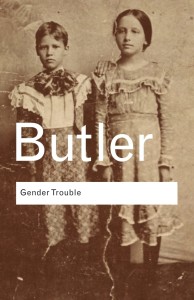 In this regard, Judith Butler (Butler 1993) notes that the body, especially the female body has been an object of the patriarchal and heterosexual paradigm; according to her, the body is not “a natural expression of the person”, but a “medium” through which to stage and reproduce human relationships and sexual differences. In particular, in Freudian and Lacanian psychoanalysis, the masculine genital organ becomes the metaphoric image of the male primacy: the symbol of anthropocentric supremacy and, therefore, the male genital representation coincides with the form of perfection in human reproduction, an ethical principle of androcentric-social equilibrium.
In this regard, Judith Butler (Butler 1993) notes that the body, especially the female body has been an object of the patriarchal and heterosexual paradigm; according to her, the body is not “a natural expression of the person”, but a “medium” through which to stage and reproduce human relationships and sexual differences. In particular, in Freudian and Lacanian psychoanalysis, the masculine genital organ becomes the metaphoric image of the male primacy: the symbol of anthropocentric supremacy and, therefore, the male genital representation coincides with the form of perfection in human reproduction, an ethical principle of androcentric-social equilibrium.
In the nineteenth century and, in particular, according to psychoanalytic science, men were able to transmit life, unlike women considered only as a passive object useful for pregnancy. In the perspective of the Freudian work of Totem und Tabu (1913), the female subject is at the center of male sexual desires, in a game of group rivalry and paternal interests. Similar position is that of the psychoanalyst Jacques Lacan. According to Lacan, the woman is in a “natural” position of sexual and procreative subordination; in this perspective, the female pleasure exists, but it is in relation to man: the “subject” for excellence. From this point of view, psychiatrist Alexander Lowen claims that the “phallic” representation is based on a narcissistic-masculine physiognomy linked in the perception of genital virility and of the woman as a lower sexual subject; the result of that is the association between virility and masculine-phallic dimension has a political importance (Lowen 2016: 246).
In these terms, female sexuality represented in the psychoanalytic tradition and in an ambivalent perspective, is designated as a “mirror” of male sexuality. In this configuration, the representation of female sexuality as a “mirror” of man highlights the theme of the body as a means on which to define the normative-patriarchal model and, consequently, the social relations on which it develops, what the sociologist and philosopher Pierre Bourdieu defined as “habitus”, a system of cultural reproduction of social rules, that is based on homologation to certain behavioural models and this behavioural homologation is produced by control implemented over the body, in particular sexuality.
«The conditionings associated with a particular class of conditions of existence produce habitus, systems of durable, transposable dispositions, structured structures predisposed to function as structuring structures, that is, as principles which generate and organize practices and representations that can be objectively adapted to their outcomes without presupposing a conscious aiming at ends or an express mastery of the operations necessary in order to attain them» (Bourdieu 1990: 53).
 In this context, sexuality is related, above all to the discourse of belonging and identity – if we think of sexual violence, with regard to ethnic conflicts.
In this context, sexuality is related, above all to the discourse of belonging and identity – if we think of sexual violence, with regard to ethnic conflicts.
Precisely, rape of women highlights, in a terrible and cruel way, the identity conflict between two groups, because rape “of the enemy’s woman” constitutes the concrete and effective act of total destruction determined against the other; in this way, the female body becomes the main term of profusion in the construction of identity. In this perspective, woman is identified as a male-derived property; woman who can cope with this “natural” inferiority through the procreation of offspring and thus, by fulfilling the greatest her “moral duty”: the procreation of children. In this sense, woman’s procreative-maternal role – as a social duty – and her sexual sphere are connected above all with reference to a procreative duty that woman must “give” to her nation as a community.
According to the anthropologist Johann Bachofen (Bachofen 1988), in the ancient patriarchal societies, women’s procreative “role” was so important because it was linked to the fertility of the land, which in turn converged with the procreation-reproduction of the community and marriage had an important value in terms of continuity of social relations. In a anthropological perspective, “through” the female body the paternal filiation is determined in the reproduction of the offspring and the community.
Consequently, in the patriarchal perspective of the “right” to patrilinearity – historically –the rape of women represents a very serious violation of this patriarchal and patrilinear “right”, as it has evident and public consequences on the reproduction of the group.
In this regard, Nira Yuval-Davis (Yuval-Davis 1996) emphasizes the female social “role” in the biological reproduction of the nation. According to her, war and sexuality are on the same level and, in this case, violence is connected to internal psychic mechanisms, in which the male drive desire is transfigured into a form of hatred against the “other”. In a historical and anthropological sense, in the logic of war, sexual relations outside marriage are considered as a social dishonor that destroys the institutional and political relations of a nation. At this level, the substantial modification of the reproductive “blood”, caused by the rape of women, in turn, determines a radical change in the sexual-national sphere of the enemy group: in this sense, female body have a performative value capable of producing a transformation on the sexual-ethnic future of a nation. In this regard, the words of Susan Brownmiller are certainly of great depth and significance:
«Men of a conquered nation traditionally view the rape of “their women” as the ultimate humiliation, a sexual coup de grace. Rape is considered by the people of a defeated nation to be part of the enemy’s conscious effort to destroy them. In fact, by tradition, men appropriate the rape of “their women” as part of their own male anguish of defeat. This egocentric view does have a partial validity. Apart from a genuine, human concern for wives and daughters near and dear to them, rape by a conqueror is compelling evidence of the conquered’s status of masculine impotence. Defense of women has long been a hallmark of masculine pride, as possession of women has been a hallmark of masculine success. Rape by a conquering soldiers destroy alla remaining illusions power and property for men of the defeated side. The body of a raped woman becomes a ceremonial battlefield, a parade ground for the victor’s trooping of the color. The act that is played out upon her is a message passed between men-vivid proof of victory for one and loss and defeat for the other» (Brownmiller 1975: 38).
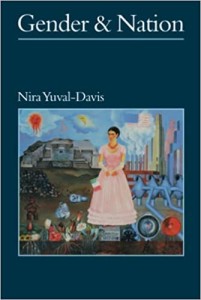 In this regard, the philosopher Michel Foucault observed that sexuality, especially female sexuality, constituted the main term of a social control enforced over the body and linked to specific social dynamics such as marriage and childbearing for women. In particular, Michel Foucault highlights the ways in which the subject determines himself through social rules and prescriptions as conditions of social life.
In this regard, the philosopher Michel Foucault observed that sexuality, especially female sexuality, constituted the main term of a social control enforced over the body and linked to specific social dynamics such as marriage and childbearing for women. In particular, Michel Foucault highlights the ways in which the subject determines himself through social rules and prescriptions as conditions of social life.
In this sense, the aspect that emerges in Foucault’s thought is the extension of individual-identity subjection to social norms: the trait is that of a “circularity” that is not limited to the exclusive reception of external regulations, but is connected to an extended between subject and society.
From this perspective, power produces a reification of the subjectivity that becomes the object of knowledge. Subjection and subjectivation of identity are on a parallel level, because, on the one hand the subject is subordinated to the rules of institutional power; on the other hand, the subject adopts these rules with the aim to assert its position and therefore, normative power coincides with a condition of identity “possibility”; whereby, the subject is constituted as such because it is placed within processes of subjugation and practices of liberation (Foucault 1994: 210).
This does not mean – Judith Butler observes – that the subject exists only insofar as it is reduced to the power of social norms, but it does mean that power, and thus its performative character, is essential for a reiteration of acts. The performative connotation of power, therefore, is evident precisely in the “repetition” of actions and behaviours that the subject takes on and reiterates over time.
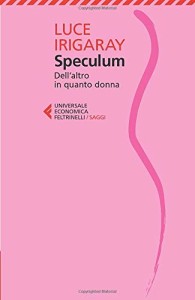 In this perspective, the performative effect of language is also evident when, through the use of certain words, certain parameters or values are attributed to one gender or another (Butler 2017: 98). In fact, as Judith Butler notes, language constitutes an important performative element, through the attribution of specific social, cultural and especially linguistic-semantic ways in which individuals are named by “gender”, which means being defined in the socially constructed “gender”. It is understood that gender norms are obviously also connected to a linguistic-performative action, an aspect which, in turn, makes the “vulnerability” of each subject emblematic when it is placed in society and relates to other individuals. In a nominal and semantic perspective, language is determined as the founding structure of social-normative power.
In this perspective, the performative effect of language is also evident when, through the use of certain words, certain parameters or values are attributed to one gender or another (Butler 2017: 98). In fact, as Judith Butler notes, language constitutes an important performative element, through the attribution of specific social, cultural and especially linguistic-semantic ways in which individuals are named by “gender”, which means being defined in the socially constructed “gender”. It is understood that gender norms are obviously also connected to a linguistic-performative action, an aspect which, in turn, makes the “vulnerability” of each subject emblematic when it is placed in society and relates to other individuals. In a nominal and semantic perspective, language is determined as the founding structure of social-normative power.
In this horizon, the “reproduction” of the genre is therefore a form of “negotiation” with power itself, essentially transforming itself into a political category, identified with the political instance of performative action; consequently, language becomes the “place” in which an identity-subjective recognition emerges and “materializes”, identified in the conventional use of terms and concepts and in the continuous reiteration of acts and actions. With regard to the concept of performative language, Judith Butler emphasizes that:
«Language assumes and alters its power to act upon the real through locutionary acts, which, repeated, become entrenched practices and, ultimately, institutions. The asymmetrical structure of language that identifies the subject who speaks for and as the universal with the male and identifies the female speaker as “particular” and “interested” is in no sense intrinsic to particular languages ot to language itself» (Butler 2006: 158).
Therefore, from Butler’s words it can be seen that gender performance, expressed publicly, is characterized by political connotations and the maintenance of cultural and sexual paradigms. In this perspective, traditional dichotomies of power and gender categorizations are positioned in the conventional use of language, and this is particularly the case when in certain situations of social, economic, professional or political conflict and opposition (as, for example, in the case wars and ethnic conflicts), inevitably, certain words are expressed from individuals or groups who have power and authority, against other human groups considered inferior and subordinate.
Dialoghi Mediterranei, n. 56, luglio 2022
[*]
Abstract
Dagli anni Sessanta e Settanta, le tematiche femministe si sono orientate nella direzione della rivendicazione e dell’autodeterminazione del corpo. La critica al patriarcato si è determinata come riflessione teorico-politica che ha assunto la configurazione di una riflessione sulla connessione normativismo eterosessuale/cultura maschile, una critica sostanziale il cui fine è stato quello di delineare le dinamiche della subordinazione femminile. In tal senso, il tema della liberazione e dell’autodeterminazione femminile sul corpo viene posto in relazione sia alla questione della maternità come istituzione ed obbligo sociale, che alla dicotomia uomo-donna. La critica femminista sottolinea pertanto le conseguenze di una specifica immagine del ‘femminile’ – erronea e più che altro connessa alla sfera sessuale e riproduttiva – che tende ad accentuare la dicotomia tra i generi, rappresentazione determinata nella riflessione filosofica occidentale (da Platone a Hegel) e poi nella psicoanalisi (con Freud e Lacan), nel momento in cui l’uomo viene identificato quale simbolo della superiorità antropocentrica, a differenza della donna considerata soltanto come “specchio” dell’uomo, il cui fine è quello di procreare figli e, perciò, contribuire alla continuità della famiglia, della comunità e, in una prospettiva antropologica, alla conservazione della patrilinearità, laddove la sessualità femminile ha costituito il termine principale di un controllo sociale esercitato a partire dal corpo e che, come nota Foucault, si è determinato nel tempo, attraverso l’assoggettamento dell’identità alle prescrizioni e regole sociali.
Riferimenti bibliografici
Bachofen J. J., Il matriarcato. Ricerca sulla ginecocrazia del mondo antico nei suoi aspetti religiosi e giuridici, tomo primo, Einaudi, Torino 1988, traduzione italiana di Das Mutterrecht (1861).
Bourdieu P., The Logic of Practice, translated by Richard Nice, Stanford University Press, Stanford, 1990.
Brownmiller Susan, Against our will. Men, women and rape, Ballantine Books, New York, 1975.
Butler J., Bodies that matter. On the discursive limits of sex, Routledge, New York, 1993.
Butler J., L’alleanza dei corpi. Note per una teoria performativa dell’azione collettiva, nottetempo, Milano, 2017, traduzione italiana di Notes towards a performative theory of assembly (Harvard University Press, Cambridge 2015).
Butler J., Gender Trouble. Feminism and the Subversion of Identity, Routledge, New York and London, 2006.
Cavaliere A., From motherhood to the symbolic order of the mother. Feminist routes starting from “the undecidable imprint”, «Revista euro-americana de teoría e historia de la política y del derecho», vol. 6/2, Julio-Diciembre 2019.
Foucault M., Dits et écrits. Tome IV, Gallimard, Paris, 1994.
Friedan B., The Feminine Mistique, Norton & Company, New York & London, 1963.
Irigaray L., Questo sesso che non è un sesso. Sulla condizione sessuale, sociale e culturale delle donne, Feltrinelli, Milano 1978: 48, traduzione di Ce sexe qui n’en est pas un (Les éditions de minuit, Paris 1977).
Irigaray L., Speculum. Of the other woman, translated by Gillian C. Gill, Cornell University Press, Ithaca, New York 1985.
Lowen A., Il linguaggio del corpo, Feltrinelli, Milano 2016, traduzione di Physical dynamics of character structure (the language of the body), (Grune and Stratton, New York 1985).
Marella M. R., Le donne, in Gli anni Settanta del diritto privato, Giuffré, Milano, 2008.
Muraro L., L’ordine simbolico della madre, Editori Riuniti, Roma, 1991-2006.
Rich A., Of Woman Born. Motherhood As Experience and Institution, Norton & Company, New York & London, 1976.
Sapegno M. S., Identità e differenze. Introduzione agli studi delle donne e di genere, Milano, Mondadori, 2011.
Vukoičić J., Radical feminism as a discourse in the theory of conflict, «Sociological discourse», year 3, number 5 / june 2013.
Yuval-Davis N., Women and the biological reproduction of “the nation”, «Women’s Studies International Forum», Volume 19, Issues 1–2, January–April, 1996.
______________________________________________________________
Laura Sugamele, dottoressa di ricerca in Studi Politici (Università “La Sapienza”), i suoi interessi di ricerca si rivolgono agli studi di genere, filosofia politica, storia del pensiero femminista con un focus sullo studio del femminismo postcoloniale. È autrice di Bioetica e femminismo. Rivisitazione dell’etica dei principi e sviluppo della competenza dell’autonomia (Stamen 2016) e Percorsi e teorie del femminismo tra storia, sviluppi e traiettorie concettuali (Aracne 2019).
______________________________________________________________



